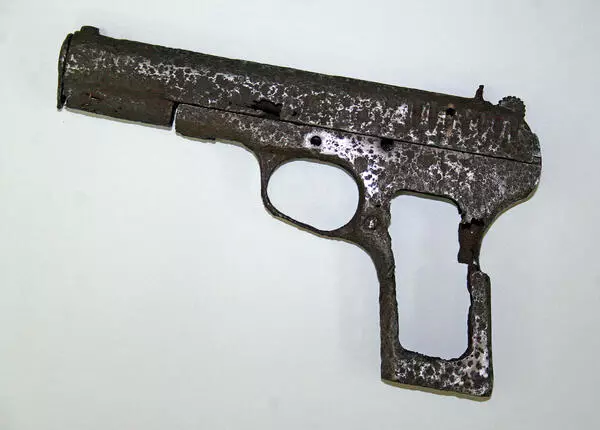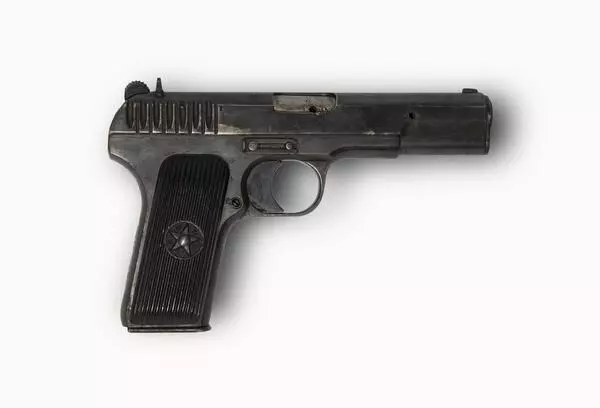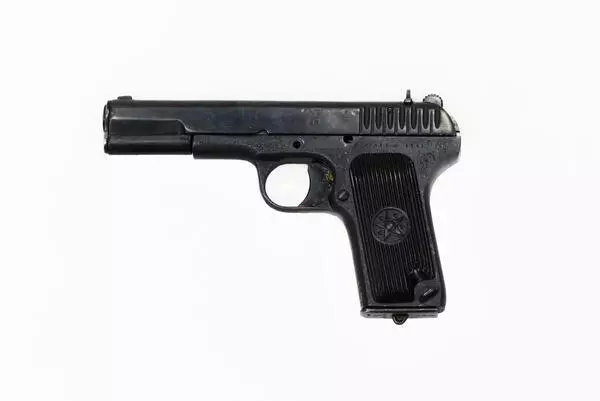The displayed rifle was developed by Fedor Vasilievich Tokarev. At that time the military command and the highest political leadership of the country sought to introduce a self-loading automatic rifle in the Red Army instead of the AVS-36 automatic rifle, which would allow to rationalize the use of cartridges and ensure better accuracy. A competition was held in the spring and autumn of 1938. During field tests, the Tokarev rifle was recognized as the best and adopted by the Red Army under the designation “7.62 mm self-loading rifle of the Tokarev system, model of 1938 — SVT-38”.
As with the AVS-36, the SVT-38 was a gas-operated rifle: its system of operation was based on harnessing the energy, resulting from the gas from the cartridge being fired, through a port in the barrel. This high-pressure gas provided motion for the entire cycle of operation. The SVT-38 was a tilting bolt action. The rifle was designed to fire one shot per single pull of the trigger. At the same time, the trigger mechanism was a separate removable unit, which greatly facilitated the assembly and cleaning of these weapons.
To increase accuracy, the SVT-38 rifle had a trigger-type firing mechanism. The use of a muzzle brake also increased the accuracy. The rifle was fed by a detachable box magazine, designed for 10 cartridges arranged in a staggered order. The magazine could be refilled without removing it from the clip inserted into the open-top receiver.
Mass production of SVT-38 rifles started in the second half of 1939 at the Tula Arms Factory, and since the beginning of 1940 — at the Izhevsk Arms Factory. The first batches of rifles were sent to the Red Army units involved in the First Soviet-Finnish War of 1939–1940. In the extreme conditions of this Winter War, when the fighting was taking place in a rugged wooded area with a snow cover of 1.5–2 m in height and at an air temperature of about -40 degrees Celsius, many disadvantages of the rifle were revealed: those included bulkiness, heavy weight, inconvenience of gas regulation, and sensitivity to dirt and low temperatures. To eliminate these shortcomings, the rifle was upgraded, and on June 1, 1940, the SVT-40, its modified version, entered production.
As with the AVS-36, the SVT-38 was a gas-operated rifle: its system of operation was based on harnessing the energy, resulting from the gas from the cartridge being fired, through a port in the barrel. This high-pressure gas provided motion for the entire cycle of operation. The SVT-38 was a tilting bolt action. The rifle was designed to fire one shot per single pull of the trigger. At the same time, the trigger mechanism was a separate removable unit, which greatly facilitated the assembly and cleaning of these weapons.
To increase accuracy, the SVT-38 rifle had a trigger-type firing mechanism. The use of a muzzle brake also increased the accuracy. The rifle was fed by a detachable box magazine, designed for 10 cartridges arranged in a staggered order. The magazine could be refilled without removing it from the clip inserted into the open-top receiver.
Mass production of SVT-38 rifles started in the second half of 1939 at the Tula Arms Factory, and since the beginning of 1940 — at the Izhevsk Arms Factory. The first batches of rifles were sent to the Red Army units involved in the First Soviet-Finnish War of 1939–1940. In the extreme conditions of this Winter War, when the fighting was taking place in a rugged wooded area with a snow cover of 1.5–2 m in height and at an air temperature of about -40 degrees Celsius, many disadvantages of the rifle were revealed: those included bulkiness, heavy weight, inconvenience of gas regulation, and sensitivity to dirt and low temperatures. To eliminate these shortcomings, the rifle was upgraded, and on June 1, 1940, the SVT-40, its modified version, entered production.







